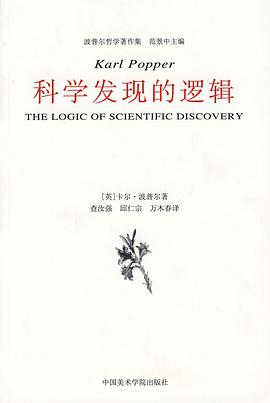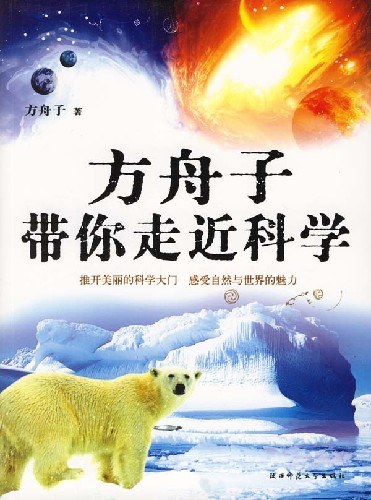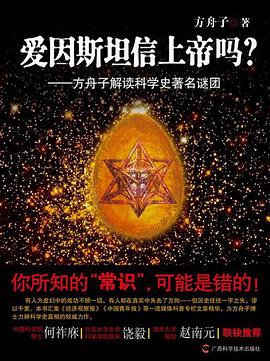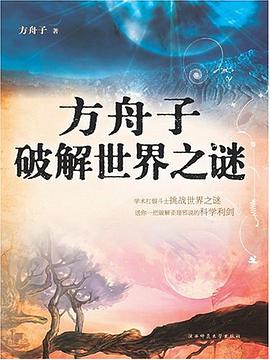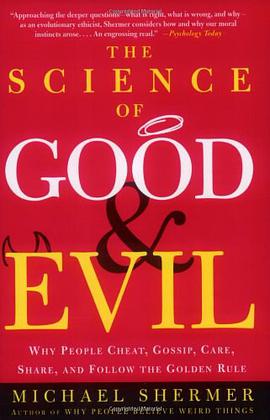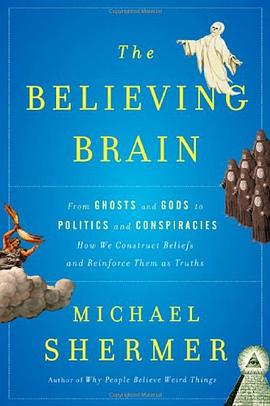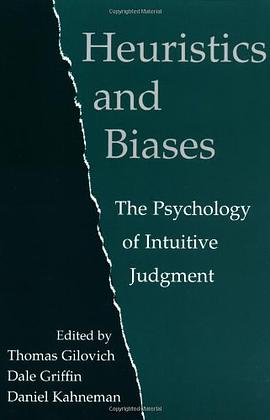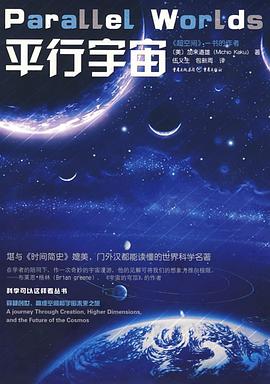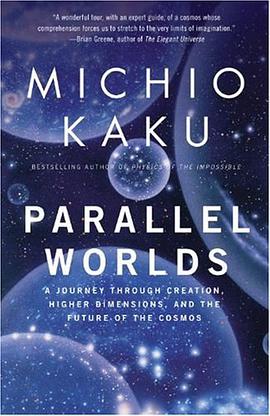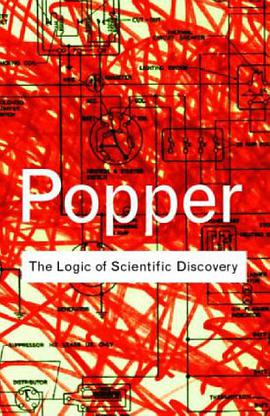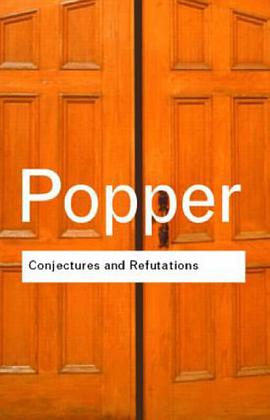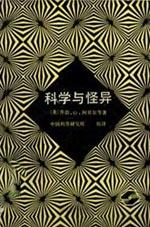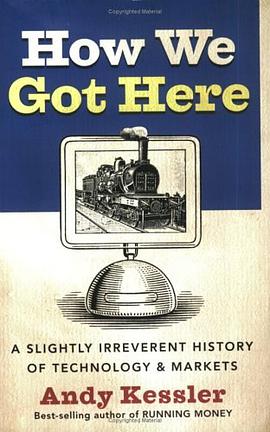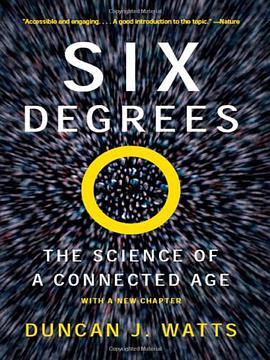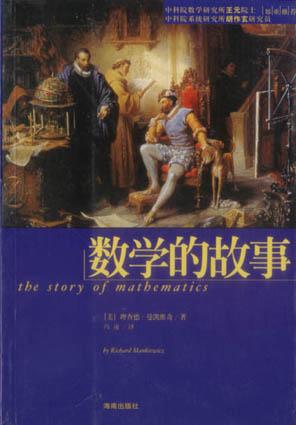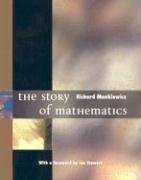科普
科学成就健康 豆瓣
7.6 (5 个评分)
作者:
方舟子
新华出版社
2007
- 1
中国何时才能有一个规范、公正的学术环境呢?这与整个社会的民主空气有
关,也与法律的健全与否有关。现在方舟子所做的只能是起到一点抑制作用,让
那些人有所收敛而已。这个工作还是很有意义的,希望方舟子能够坚持下去,并
争取多在国内公开发表一些东西。
——中国科学院院士、著名生物化学家 邹承鲁
书中最有价值的部分,是开列了一大批虚假保健品,开列了一大批做夸大宣
传的营养品。揭露“陷阱”,点名道姓,不讲情面。这才是真正对人民负责的科
学精神。
——中国科学院院士 何祚庥
保健品泛滥实际上是有害于中国人民的全体利益的。因为当人民把现在还有
限的收入,过度投入到无益的“营养保健品”中去的时候,人民可以用于有益的
药物的钱就少了。同样,当企业和商业热心地推销和不断翻新各种无益的保健品,
企业和商业用于生产和推销对人民有益的产品的时间和经费就少了。所以,推出
无益的保健品是损害中国人民整体利益的。
——美国西北大学神经生物学教授 饶毅
关,也与法律的健全与否有关。现在方舟子所做的只能是起到一点抑制作用,让
那些人有所收敛而已。这个工作还是很有意义的,希望方舟子能够坚持下去,并
争取多在国内公开发表一些东西。
——中国科学院院士、著名生物化学家 邹承鲁
书中最有价值的部分,是开列了一大批虚假保健品,开列了一大批做夸大宣
传的营养品。揭露“陷阱”,点名道姓,不讲情面。这才是真正对人民负责的科
学精神。
——中国科学院院士 何祚庥
保健品泛滥实际上是有害于中国人民的全体利益的。因为当人民把现在还有
限的收入,过度投入到无益的“营养保健品”中去的时候,人民可以用于有益的
药物的钱就少了。同样,当企业和商业热心地推销和不断翻新各种无益的保健品,
企业和商业用于生产和推销对人民有益的产品的时间和经费就少了。所以,推出
无益的保健品是损害中国人民整体利益的。
——美国西北大学神经生物学教授 饶毅
爱因斯坦信上帝吗? 豆瓣
作者:
方舟子
2009
- 8
要真正了解科学史,就读《爱因斯坦信上帝吗?(方舟子解读科学史著名谜团)》!
★当代中国最有影响力的科普作家方舟子最新力作!《爱因斯坦信上帝吗?(方舟子解读科学史著名谜团)》汇集《经济观察报》《中国青年报》等一流媒体科普专栏文字精华,为方舟子博士力辨科学史真相的权威力作。
★困惑人们多年的科学史谜团,究竟还有哪些是我们所不知道的真实?在课堂上,你的老师绝不可能告诉你这些事儿!
★中国科学院院士何祚庥、北京大学生命科学学院院长饶毅、清华大学教授赵南元联袂推荐
★《爱因斯坦信上帝吗?(方舟子解读科学史著名谜团)》出版前,中信出版社、广西师范大学出版社、人民日报出版社等多家知名出版社纷纷向作者邀约此书出版。
科普作家方舟子以独特的视角逐一透视科学史上的著名谜团!在课堂上,你的老师绝不可能告诉你这些事儿!
★当代中国最有影响力的科普作家方舟子最新力作!《爱因斯坦信上帝吗?(方舟子解读科学史著名谜团)》汇集《经济观察报》《中国青年报》等一流媒体科普专栏文字精华,为方舟子博士力辨科学史真相的权威力作。
★困惑人们多年的科学史谜团,究竟还有哪些是我们所不知道的真实?在课堂上,你的老师绝不可能告诉你这些事儿!
★中国科学院院士何祚庥、北京大学生命科学学院院长饶毅、清华大学教授赵南元联袂推荐
★《爱因斯坦信上帝吗?(方舟子解读科学史著名谜团)》出版前,中信出版社、广西师范大学出版社、人民日报出版社等多家知名出版社纷纷向作者邀约此书出版。
科普作家方舟子以独特的视角逐一透视科学史上的著名谜团!在课堂上,你的老师绝不可能告诉你这些事儿!
方舟子破解世界之谜 豆瓣
作者:
方舟子
陕西师范大学出版社
2007
- 1
《方舟子破解世界之谜》讲述古埃及在文明古国中,是历史最为悠久的一个。从公元前3150年完成统一立国,一直到公元前332年被古希腊征服,在长达三千年的历史中,古埃及人民创造了光辉灿烂的文化。其中最令人叹为观止的、成了古埃及象征的就是金字塔了,最大的金字塔(胡夫金字塔,也称做大金字塔)至今还是世界上最重的建筑物。有关这座宏伟建筑物的种种传说、神秘故事,还时见报端。概括起来,这类神话和鬼话可分成三类:一,据说大金字塔暗藏着种种神奇的数字,甚至暗藏着人类的全部历史和未来;二,据说金字塔有种种魔力;三,据说古埃及人没有能力建造大金字塔,大金字塔是外星人建的。
The Science of Good and Evil 豆瓣
作者:
Michael Shermer
Holt Paperbacks
2005
- 1
From bestselling author Michael Shermer, an investigation of the evolution of morality that is "a paragon of popularized science and philosophy" The Sun (Baltimore) A century and a half after Darwin first proposed an "evolutionary ethics," science has begun to tackle the roots of morality. Just as evolutionary biologists study why we are hungry (to motivate us to eat) or why sex is enjoyable (to motivate us to procreate), they are now searching for the very nature of humanity. In "The Science of Good and Evil," science historian Michael Shermer explores how humans evolved from social primates to moral primates; how and why morality motivates the human animal; and how the foundation of moral principles can be built upon empirical evidence. Along the way he explains the implications of scientific findings for fate and free will, the existence of pure good and pure evil, and the development of early moral sentiments among the first humans. As he closes the divide between science and morality, Shermer draws on stories from the Yanamamo, infamously known as the "fierce people" of the tropical rain forest, to the Stanford studies on jailers' behavior in prisons. "The Science of Good and Evil" is ultimately a profound look at the moral animal, belief, and the scientific pursuit of truth.
The Believing Brain 豆瓣 Goodreads
作者:
Michael Shermer
Times Books
2011
- 5
The Believing Brain is divided into four parts. Part I, “Journeys of Belief,” includes personal narratives of belief, including that of the author; Part II, “The Biology of Belief,” bores into the brain and explains how the mind works to form beliefs, from thoughts and ideas down to neurons firing across tiny synaptic gaps as they talk to one another chemically; Part III, “Belief in Things Unseen” applies my theory beliefs to the afterlife, God, aliens, and conspiracies; and Part IV, “Belief in Things Seen,” examines the role of beliefs in politics, economics, and ideologies, explains how belief confirmation works to assure that we are always right, and then explores the history of scientific exploration, from the world to the cosmos, and how science works to overcome the power of belief.
The Believing Brain begins with three personal belief stories. The first story is about a man whom you will have never heard of but who had a profound and life-changing experience in the wee hours of the morning many decades ago that still haunts him to this day and drives him to search for ultimate meaning in the cosmos. The second story is about a man whom you will most definitely have heard of as he is one of the greatest scientists of our age, and he too had a life-changing early-morning experience that confirmed his decision to make a religious leap of faith. The third story is Dr. Shermer’s own passage from believer to skeptic, and what he learned along the way that drove him into a professional career of the scientific study of belief systems.
From narrative stories Dr. Shermer turns to an architecture of belief systems, how they are formed, nourished, reinforced, changed, and extinguished, first conceptually through the two theoretical constructs he developed called patternicity and agenticity, and then delve deeper into how these cognitive processes evolved and what purpose they served in the lives of our ancestors as well as in our lives today. Dr. Shermer then bores deeper into the brain, right down to the neurophysiology of belief system construction at the single neuron level, and then reconstructs from the bottom up how brains form beliefs. Then we shall examine how belief systems operate with regard to belief in religion, the afterlife, God, extraterrestrials, conspiracies, politics, economics, and ideologies of all stripes, and then consider how a host of cognitive processes convince us that our beliefs are truths. In the final chapters we will consider how we know any of our beliefs are believable, which patterns are true and which false, which agents are real and which are chimera, and how science works as the ultimate pattern detection device.
In the end, all of us are trying to make sense of the world, and nature has gifted us with a double-edge sword that cuts for and against. On one edge, our brains are the most complex and sophisticated information processing machines in the universe, capable of understanding not only the universe itself but of understanding the process of understanding. On the other edge, by the very same process of forming beliefs about the universe and ourselves, we are also more capable than any other species of self-deception and illusion, of fooling ourselves while we are trying to avoid being fooled by nature.
The Believing Brain begins with three personal belief stories. The first story is about a man whom you will have never heard of but who had a profound and life-changing experience in the wee hours of the morning many decades ago that still haunts him to this day and drives him to search for ultimate meaning in the cosmos. The second story is about a man whom you will most definitely have heard of as he is one of the greatest scientists of our age, and he too had a life-changing early-morning experience that confirmed his decision to make a religious leap of faith. The third story is Dr. Shermer’s own passage from believer to skeptic, and what he learned along the way that drove him into a professional career of the scientific study of belief systems.
From narrative stories Dr. Shermer turns to an architecture of belief systems, how they are formed, nourished, reinforced, changed, and extinguished, first conceptually through the two theoretical constructs he developed called patternicity and agenticity, and then delve deeper into how these cognitive processes evolved and what purpose they served in the lives of our ancestors as well as in our lives today. Dr. Shermer then bores deeper into the brain, right down to the neurophysiology of belief system construction at the single neuron level, and then reconstructs from the bottom up how brains form beliefs. Then we shall examine how belief systems operate with regard to belief in religion, the afterlife, God, extraterrestrials, conspiracies, politics, economics, and ideologies of all stripes, and then consider how a host of cognitive processes convince us that our beliefs are truths. In the final chapters we will consider how we know any of our beliefs are believable, which patterns are true and which false, which agents are real and which are chimera, and how science works as the ultimate pattern detection device.
In the end, all of us are trying to make sense of the world, and nature has gifted us with a double-edge sword that cuts for and against. On one edge, our brains are the most complex and sophisticated information processing machines in the universe, capable of understanding not only the universe itself but of understanding the process of understanding. On the other edge, by the very same process of forming beliefs about the universe and ourselves, we are also more capable than any other species of self-deception and illusion, of fooling ourselves while we are trying to avoid being fooled by nature.
Heuristics and Biases 豆瓣
作者:
Thomas Gilovich (EDT)
/
Dale W. Griffin (EDT)
…
Cambridge University Press
2002
- 7
Is our case strong enough to go to trial? Will interest rates go up? Can I trust this person? Such questions - and the judgments required to answer them - are woven into the fabric of everyday experience. This 2002 book examines how people make such judgments. The study of human judgment was transformed in the 1970s, when Kahneman and Tversky introduced their 'heuristics and biases' approach and challenged the dominance of strictly rational models. Their work highlighted the reflexive mental operations used to make complex problems manageable and illuminated how the same processes can lead to both accurate and dangerously flawed judgments. The heuristics and biases framework generated a torrent of influential research in psychology - research that reverberated widely and affected scholarship in economics, law, medicine, management, and political science. This book compiles the most influential research in the heuristics and biases tradition since the initial collection of 1982 (by Kahneman, Slovic, and Tversky).
Parallel Worlds 豆瓣
作者:
Michio Kaku
Anchor
2006
- 2
In this thrilling journey into the mysteries of our cosmos, bestselling author Michio Kaku takes us on a dizzying ride to explore black holes and time machines, multidimensional space and, most tantalizing of all, the possibility that parallel universes may lay alongside our own.
Kaku skillfully guides us through the latest innovations in string theory and its latest iteration, M-theory, which posits that our universe may be just one in an endless multiverse, a singular bubble floating in a sea of infinite bubble universes. If M-theory is proven correct, we may perhaps finally find answer to the question, “What happened before the big bang?” This is an exciting and unforgettable introduction into the new cutting-edge theories of physics and cosmology from one of the pre-eminent voices in the field.
Kaku skillfully guides us through the latest innovations in string theory and its latest iteration, M-theory, which posits that our universe may be just one in an endless multiverse, a singular bubble floating in a sea of infinite bubble universes. If M-theory is proven correct, we may perhaps finally find answer to the question, “What happened before the big bang?” This is an exciting and unforgettable introduction into the new cutting-edge theories of physics and cosmology from one of the pre-eminent voices in the field.
The Logic of Scientific Discovery 豆瓣 Goodreads Goodreads
Logik der Forschung: Zur Erkenntnistheorie der modernen Naturwissenschaft
作者:
Karl Popper
Routledge
2002
- 3
When first published in 1959, this book revolutionized contemporary thinking about science and knowledge. It remains the one of the most widely read books about science to come out of the twentieth century.
Conjectures and Refutations 豆瓣
作者:
Karl Popper
Routledge
2002
- 5
在线阅读本书
One of Karl Popper's most wide-ranging and popular works, it provides the clearest statement of the fundamental idea that guided his work: that our knowledge grows by an unending process of trial and error.
One of Karl Popper's most wide-ranging and popular works, it provides the clearest statement of the fundamental idea that guided his work: that our knowledge grows by an unending process of trial and error.
How We Got Here 豆瓣
作者:
Andy Kessler
HarperBusiness
2005
- 6
Best-selling author Andy Kessler ties up the loose ends from his provocative book, Running Money, with this history of breakthrough technology and the markets that funded them. Expanding on themes first raised in his tour de force, Running Money, Andy Kessler unpacks the entire history of Silicon Valley and Wall Street, from the Industrial Revolution to computers, communications, money, gold and stock markets. These stories cut (by an unscrupulous editor) from the original manuscript were intended as a primer on the ways in which new technologies develop from unprofitable curiosities to essential investments. Indeed, How We Got Here is the book Kessler wishes someone had handed him on his first day as a freshman engineering student at Cornell or on the day he started on Wall Street. This book connects the dots through history to how we got to where we are today.
发现之旅 豆瓣 Goodreads
voyages of discovery
8.6 (24 个评分)
作者:
[英] 托尼·赖斯
译者:
林洁盈
商务印书馆
2012
- 1
《发现之旅》,绝对值得您珍藏!——历史上最伟大的十次自然探险
蒐集伦敦自然史博物馆300余帧精美的珍藏画作/视觉上的一场饕餮盛宴/
世界历史上最著名的探险家、科学家、艺术家联袂演绎/一幕幕迷人的自然历史冒险故事 /三百年历史的时间隧道,携您加入未知领域的探险/与历史伟人一起遨游世界
这本书实在很难让人(剪)刀下留情,它太美了,几乎每张素描画作都在低语诉说:“将我剪下来,贴在墙上吧!”——《国家地理杂志》
《发现之旅》是一部迷人的视觉盛宴,蒐集了伦敦自然史博物馆里数百幅珍贵藏品,收录了历史上十次最重要的自然探险故事,叙述了那些世界知名探险家、生物学家、艺术家在深入海洋深处挖掘深海秘密时的一幕幕冒险旅程。
本书以过去三百年间最有趣也最重要的自然科学探索之旅为题,聚焦在航程中搜集到的艺术与图像材料。每一趟旅程都累积了极其重要的标本收藏,产生了重要的科学新知。书中的许多博物馆收藏也是第一次面世,它们绝对值得读者悉心鉴赏。过去一代代的科学家与历史学家都曾深深地为这些故事与图像着迷,并从中获得了阅读的乐趣。这本书的出版提醒我们,自然环境保护的重要性及自然艺术家在自然科学演替过程中的贡献不容忽视。我们若有机会到世界各地去旅行,可以说每一次都是开启视野、航向未知世界的新探险。最好是随身携带这本书,在车上或飞机上随意翻阅,说不定它会给您新的领悟与启示。
蒐集伦敦自然史博物馆300余帧精美的珍藏画作/视觉上的一场饕餮盛宴/
世界历史上最著名的探险家、科学家、艺术家联袂演绎/一幕幕迷人的自然历史冒险故事 /三百年历史的时间隧道,携您加入未知领域的探险/与历史伟人一起遨游世界
这本书实在很难让人(剪)刀下留情,它太美了,几乎每张素描画作都在低语诉说:“将我剪下来,贴在墙上吧!”——《国家地理杂志》
《发现之旅》是一部迷人的视觉盛宴,蒐集了伦敦自然史博物馆里数百幅珍贵藏品,收录了历史上十次最重要的自然探险故事,叙述了那些世界知名探险家、生物学家、艺术家在深入海洋深处挖掘深海秘密时的一幕幕冒险旅程。
本书以过去三百年间最有趣也最重要的自然科学探索之旅为题,聚焦在航程中搜集到的艺术与图像材料。每一趟旅程都累积了极其重要的标本收藏,产生了重要的科学新知。书中的许多博物馆收藏也是第一次面世,它们绝对值得读者悉心鉴赏。过去一代代的科学家与历史学家都曾深深地为这些故事与图像着迷,并从中获得了阅读的乐趣。这本书的出版提醒我们,自然环境保护的重要性及自然艺术家在自然科学演替过程中的贡献不容忽视。我们若有机会到世界各地去旅行,可以说每一次都是开启视野、航向未知世界的新探险。最好是随身携带这本书,在车上或飞机上随意翻阅,说不定它会给您新的领悟与启示。
6個人的小世界 豆瓣
6 Degrees: The Science of a Connected Age
作者:
鄧肯.華茲 (Duncan J. Watts)
译者:
傅士哲
/
謝良瑜
大塊文化
2009
- 8
「我從某處得知,在地球上,人與人之間只被六個人隔絕。六度的分隔,正是這個星球的人際距離。」--舞台劇《六度分離》中歐莎之語,作者約翰.桂爾(John Guare)
沒有一件事會毫無理由,憑空發生。在這連結的時代裡,什麼會發生、如何發生,彼此之間都是環環相扣的。頂頂有名的「六度分隔」理論,指的是任何兩個不相干的人,可經由六個人連結出某種關係。正因如此,世界顯得如此之小。而當世界僅以六度延伸,事情蔓延的速度與廣度遠超過你我所能想像。螢火蟲的發光、蟋蟀的叫聲,以及心律細胞的跳動,如何自動調節出同步頻率?單一病例,如何衍生為大規模的傳染病?新穎的觀念,如何造就時尚?個別投資者如何引爆投機泡沫,並傷及整體財務系統?面對隨機的意外或甚至刻意的攻擊,電路、網際網路等大型基礎網路又是何其脆弱?規範習俗如何在人類社會中開展維繫,並被推翻甚或取代? �歸根結柢,在極端複雜的世界裡,個別行為究竟如何集結成群體行為?新興的「網路科學」,指涉六個人的小世界,其實就是一切事物的原點。
沒有一件事會毫無理由,憑空發生。在這連結的時代裡,什麼會發生、如何發生,彼此之間都是環環相扣的。頂頂有名的「六度分隔」理論,指的是任何兩個不相干的人,可經由六個人連結出某種關係。正因如此,世界顯得如此之小。而當世界僅以六度延伸,事情蔓延的速度與廣度遠超過你我所能想像。螢火蟲的發光、蟋蟀的叫聲,以及心律細胞的跳動,如何自動調節出同步頻率?單一病例,如何衍生為大規模的傳染病?新穎的觀念,如何造就時尚?個別投資者如何引爆投機泡沫,並傷及整體財務系統?面對隨機的意外或甚至刻意的攻擊,電路、網際網路等大型基礎網路又是何其脆弱?規範習俗如何在人類社會中開展維繫,並被推翻甚或取代? �歸根結柢,在極端複雜的世界裡,個別行為究竟如何集結成群體行為?新興的「網路科學」,指涉六個人的小世界,其實就是一切事物的原點。
Six Degrees 豆瓣
作者:
Duncan J Watts
W. W. Norton & Co.
2004
- 2
In this remarkable book, Duncan Watts, one of the principal architects of network theory, sets out to explain the innovative research that he and other scientists are spearheading to create a blueprint of our connected planet. Whether they bind computers, economies, or terrorist organizations, networks are everywhere in the real world, yet only recently have scientists attempted to explain their mysterious workings. From epidemics of disease to outbreaks of market madness, from people searching for information to firms surviving crisis and change, from the structure of personal relationships to the technological and social choices of entire societies, Watts weaves together a network of discoveries across an array of disciplines to tell the story of an explosive new field of knowledge, the people who are building it, and his own peculiar path in forging this new science.
数学的故事 豆瓣
作者:
理查德・曼凯维奇
译者:
冯速
海南出版社
2002
- 7
数学是怎样发展起来的,又是出自于什么样的原因发展起来的?在人类社会的发展和变革中,数学产生了怎样的影响?我们对宇宙的认识又是怎样根据数学的知识而形成的?
在这本浅显易懂的书中,理查德・曼凯维奇将给我们讲述跨越不同文化背景和不同文化领域的这一精妙的人类智慧的故事,并且告诉我们数学并非只是少数哲学家、牧师及科学家想像出来的东西,数学以这样或那样的方式介入了人类活动的各个领域。史前的神秘的记账捧、贸易、探险和作战用的地图、充满魅力的天体运行、艺术审美观的变迁和图像科学,所有这些都证实了在人类历史中数学的核心作用。
书中使用了大量丰富多彩的图片,展示这一科学的变化轨迹。从豪华灿烂的中世纪的手稿到达利及杜尚的震撼人心的艺术杰作;从巴比伦泥土板的简朴美到计算机生成图像的精美组成,通过中世纪欧洲伟大翻译家破解中国文明和印度文明,一直到科学革命和数字革命,作者用浅显易懂的语言记述了数学发展的历史过程。书中既生动形象地描述了众所周知的伟人如开普勒、哥白尼等人的故事,同时也对数学领域的伟人如阿贝尔、欧拉等人进行了生动形象的描述。《数学的故事》是历史、传记及大众科学的巧妙集成。它使我们得以了解以前从没意识到的数学的重要性、数学发展的内幕以及它的魅力。
在这本浅显易懂的书中,理查德・曼凯维奇将给我们讲述跨越不同文化背景和不同文化领域的这一精妙的人类智慧的故事,并且告诉我们数学并非只是少数哲学家、牧师及科学家想像出来的东西,数学以这样或那样的方式介入了人类活动的各个领域。史前的神秘的记账捧、贸易、探险和作战用的地图、充满魅力的天体运行、艺术审美观的变迁和图像科学,所有这些都证实了在人类历史中数学的核心作用。
书中使用了大量丰富多彩的图片,展示这一科学的变化轨迹。从豪华灿烂的中世纪的手稿到达利及杜尚的震撼人心的艺术杰作;从巴比伦泥土板的简朴美到计算机生成图像的精美组成,通过中世纪欧洲伟大翻译家破解中国文明和印度文明,一直到科学革命和数字革命,作者用浅显易懂的语言记述了数学发展的历史过程。书中既生动形象地描述了众所周知的伟人如开普勒、哥白尼等人的故事,同时也对数学领域的伟人如阿贝尔、欧拉等人进行了生动形象的描述。《数学的故事》是历史、传记及大众科学的巧妙集成。它使我们得以了解以前从没意识到的数学的重要性、数学发展的内幕以及它的魅力。
The Story of Mathematics 豆瓣
作者:
Richard Mankiewicz
Princeton University Press
2004
- 7
The mysterious tally sticks of prehistoric peoples and the terrestrial maps used for trade, exploration, and warfare; the perennial fascination with the motions of heavenly bodies and changed perspectives on the art and science of vision: all are testament to a mathematics at the heart of history. This visually stunning volume takes the reader on an illustrated tour of mathematics across cultures and civilizations, bringing to life a world of important ideas and - rarely supposed - great intrigue and charm. The development of mathematics can be seen in a wealth of images, from the richly illuminated manuscripts of the Middle Ages to the deeply unsettling art of Dali and Duchamp, from the austere beauty of Babylonian clay tablets to the delicate complexity of computer-generated pictures.These images, and many others, are lavishly reproduced to accompany a text that travels from the dawn of Chinese and Indian civilizations to the scientific and digital revolutions of our day. Including portraits of household names such as Kepler and Copernicus as well as lesser-known but equally compelling figures like Niels Henrik Abel and Leonhard Euler, "The Story of Mathematics" is a rich amalgam of history, biography, and popular science. Readers will come away understanding how and why mathematics evolved as it did - of how it entered and remained close to the center of every area of human activity. Explaining mathematical concepts without equations, Richard Mankiewicz enables us to appreciate this essential intellectual occupation without 'doing the math'.
